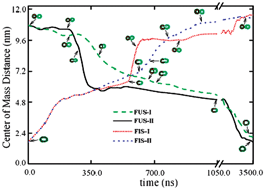Fusion and fission pathways of vesicles from amphiphilic triblock copolymers: a dissipative particle dynamics simulation study
Abstract
Dissipative particle dynamics (DPD) simulations are employed to study the fusion and fission dynamics of polymeric vesicles formed from amphiphilic


 Please wait while we load your content...
Please wait while we load your content...